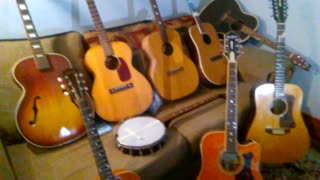How to Buy Acoustic Guitars for Beginners [Tips Test Compare]
This Guitar Basics for Beginners video will provide tips how to test, compare and buy acoustic guitars.
Guitar Lessons for Beginners Playlist
https://www.youtube.com/watch?v=SYgokBGzWJc&list=PLOKVJibwUTbqrooPJ2YJPLeqP1qWmE1z-
How to Buy Acoustic Guitars for Beginners [Tips Test Compare]
0:00 Buying Your First Guitar
0:20 Steel-String Acoustics
1:07 Buying Online
1:36 'Point of Purchase'
1:56 Play Higher-Priced Models
2:43 Tune Before Testing
2:59 Comparing Tone
3:35 Test the Action
4:47 Finish on Fretboard
5:25 Guarantees
5:44 Summary
How to Buy Acoustic Guitars for Beginners
To buy an acoustic guitar can be a very intimidating experience. Not only are there many factors involved how to compare acoustic guitars, but there is also the nerve-racking experience to test acoustic guitars in front of someone (usually the seller). This how to buy your first guitar for beginners video offers tips on how to test and compare acoustic guitars.
Best Acoustic Guitars for Beginners
For most guitarists, a steel-string acoustic is the best fist guitar model to learn with due to its versatility. Most strumming or ‘sing-along’ songs are played on steel-string acoustics, ranging in styles from folk, to country, to rock. Many popular fingerstyle songs also feature steel-string acoustic guitars.
Learning to play on a steel-string acoustic will develop enough finger strength so that switching over to play an electric or nylon-string guitar will not be so challenging, while initially learning on an electric or nylon-string guitar will not develop enough finger strength to later play a steel-string acoustic effectively.
Tips How to Test Acoustic Guitars
The more playing experience one has, the better judge one will be to test and compare acoustic guitars to determine which particular guitar works best for oneself. Having the ability to apply various playing techniques (strumming, fingerstyle, and rhythm) is essential to test and compare the versatility and overall playability of an acoustic guitar. Other personal preference factors, such as determining the right ‘fit’ or model size, or comparing tone between guitars, can only be done by picking up and playing the guitar rather than relying on someone else’s opinion.
Like anything else, to buy a your first guitar from a reputable dealer is a much safer bet than buying used from an individual. Only those guitarists with years of playing and buying experience usually do well in the used market, because regardless of price, there are many ‘spec’s’ or details you need to test and compare in order to determine the playability and actual value your first acoustic guitar.
How to Compare Acoustic Guitars
Many times, a student who has been learning and practicing on an entry-level guitar eventually will test and compare a higher-priced ($1,000+) acoustic guitar for the first time and is surprised how much ‘easier’ the more-expensive guitar is to play. Even though certain guitars may be outside of ones’s budget, to test and compare higher-priced acoustic guitars gives a guitarist a better perspective on how a lower-priced guitar should play and sound.
Make sure the guitar is properly in tune. Guitars that are tuned too high or low may hide certain flaws that may not be easy to detect unless the guitar is properly tuned.
‘Action’, which is the actual space or distance in between the strings and the fingerboard, is probably the most important factor to compare and test acoustic guitars. ‘High-action’ means the strings are too high off the fretboard, which require the fretting fingers to press down harder in order to play notes clearly. ‘Low-action’ means the strings are positioned too close to the fretboard, which results in ‘buzzing’ or sometimes even ‘dead’ areas where no sound comes from fretted notes.
To compare the tone of guitars, it isn’t necessary to try and be a virtuoso by playing complex riffs. Simply playing slow, open-chord arpeggios gives even the most-experienced guitar player a good sense of the overall tone of a guitar. Many times tone quality is just a matter of personal preference.
Paluzzi Guitar
The objective of the Paluzzi Guitar video and book series is to help establish a foundation of guitar fundamentals by applying various playing techniques (rhythm, fingerstyle, and soloing) to various styles of music. The more playing styles and techniques a guitarist can learn, the more diverse and self-sufficient a guitarist will become. A self-sufficient guitarist can then teach themselves, communicate with other musicians, and even write their own music once a solid foundation of fundamentals is established.
The Creative Guitarist Method Series was written and designed by Kevin J. Paluzzi of Paluzzi Guitar Instruction in San Diego, CA. For more information on private lessons and books, go to:
-
![Best Acoustic Guitars for Beginners [Reviews Kids]](https://hugh.cdn.rumble.cloud/s/s8/1/e/5/7/o/e57oc.0kob-small-Best-Acoustic-Guitars-for-B.jpg) 5:59
5:59
PaluzziGuitar
2 years agoBest Acoustic Guitars for Beginners [Reviews Kids]
5781 -
 0:30
0:30
theSaltshakers
2 years agoOriginal instrumental acoustic guitars
71 -
 59:40
59:40
Efon35
2 years agoHow to swim beginners
21 -
 2:40
2:40
KyleWhite1986
2 years agoAcoustic G(9)
26 -
 1:56
1:56
ZIPZIPSON
2 years agoMy acoustic guitars so far for 2021. 1937 Gibson L-50 arch top
27 -
 LIVE
LIVE
Major League Fishing
2 days agoLIVE Tackle Warehouse Invitationals, Heavy Hitters, Day 1
297 watching -
 2:20:49
2:20:49
Roseanne Barr
1 day ago $30.79 earnedWe finally got Ryan Long!!!! | The Roseanne Barr Podcast #48
155K275 -
 2:19:09
2:19:09
Steven Crowder
3 days ago🔴 UNDERCOVER EXCLUSIVE: Exposing DEI in the United States Military
710K1.42K -
 55:38
55:38
Russell Brand
1 day agoWHO "Murdered" People In Ebola Clinical Trails!! Dr Dave Martin EXPOSES WHO Like Never Before - SF #368
330K863 -
 1:26:52
1:26:52
Real Coffee With Scott Adams
10 hours agoEpisode 2478 CWSA 05/18/24
70.6K57